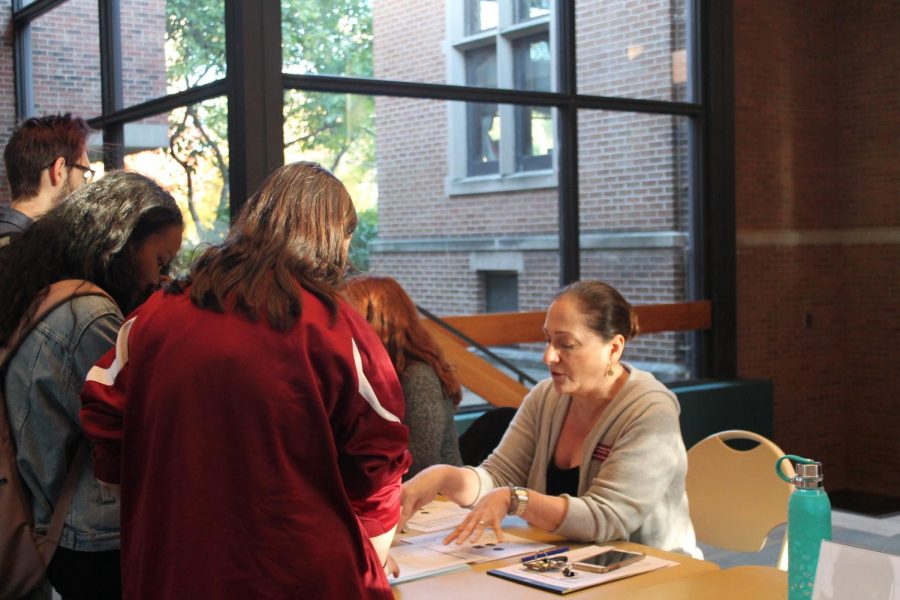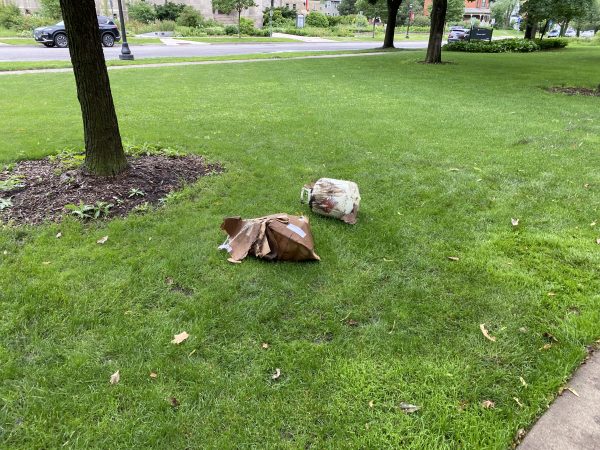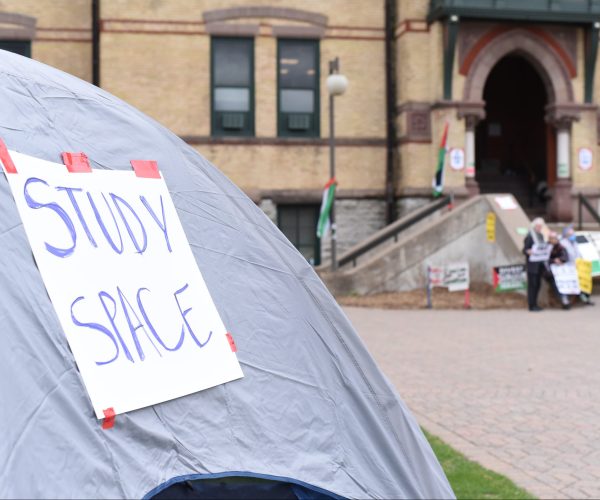Learn your studies and campus
Tuesday, Oct. 16 all of campus filled with food, fun and information on the majors offered at Hamline from students and professors alike.
Robin Parritz, head of the Psychology Department, explaining the requirements to graduate from Hamline with a psych degree.
October 30, 2018
The smell of pizza and the thrill of students wafted through Giddens Learning Center (GLC) on Tuesday night. The students milled from booth to booth, meeting professors and declared majors, excited to sink their teeth into the programs that spark their interests and passions.
Students like first-year Alana Crawford were ready to meet their prospective advisers and learn about the things that remained unclear in the fields they were interested.
“I think it’s really cool because I can get questions answered,” Crawford explained. “When I talked to admissions they didn’t know about my major… I’m looking at the 3 by 3 program. I was confused, I had a few questions they couldn’t answer… Now I’ve gotten those answered and built connections.”
Junior Maddy Bygd, a biochemistry major and volunteer at the biochemistry table, saw this opportunity as well. Excited to answer the questions of first-years and others undeclared and tell them about her own experience, Bygd talked about her favorite parts of the fair.
“I really enjoy giving students advice when they have no idea what they’re doing, or even when they do,” Bygd said. “The advice I got my first year really helped me. My favorite part of tonight, though, is seeing if students are interested in research, and if they are, advising them on research.”
Bygd was one of many volunteering students who want to share their passion for their studies with students, and give them insider knowledge.
Junior Elaina Tueffel, an anthropology and religion double major, had been volunteering at the religion booth and ventured down to the anthropology lab where they were serving Ethiopian food to discuss her studies with her professor.
“I didn’t come [to Major Exploration Night] when I was a first-year, but I’ve been volunteering at the religion booth,” Tueffel said. “I enjoy telling students about my majors… and my goals. I want to be a religious archaeologist, it’s been so interesting to see how the two subjects intersect.”
Intersecting majors and connections that one may not have first seen was a recurrent theme for some students, like first-year Parker Reindahl.
“I think it’s a really good opportunity to see all the options and how they connect,” Reindahl said, motioning to the tables in GLC. “I think it’s cool how they’re grouped… I came to get an idea of what I want to do, for the food and to meet the faculty, and of course for throwdown points… It’s good to meet faculty and see who you’d be working with, which is very important to me.”
Students were not the only ones excited for the opportunity to meet and connect. Faculty members also expressed excitement to share their knowledge in their fields.
Anthropology Professor Matt Sumera, was chatting with declared majors and searching students alike over the Ethiopian dinner offered by the Anthropology department.
“I think we’ve had over fifty students stop by today, and about 30% feel extremely driven,” Sumera said of the students he talked with. “We’ve had lots of returners as well… For me, if you’re connecting you’re trying to find the right people. We want to have lots of contemporary students to… show what the major really is, who it is.”
Sumera believes students are not only searching for the thing to study, but who to study it with. The people who you meet during research, class or internships can become lifelong friends; they can change your life in many ways.
“I think it’s super cool and a great opportunity for students to connect to other students,” Sumera said. “If you’re a major you want to find your people.”
Julia Saunders, a chemistry professor and Hamline alumna recalled how the fair has changed over the years, going from nearly nothing in her time as a student to a poster presentation in Anderson, to two years ago when the fair started.
“I don’t think they had anything like this when I was a student,” Saunders explained. “I’ve been here for 5 years, they had posters in Anderson and students would walk by… The best thing about this fair is the ability to actually talk in a very informal setting… Working on talking to people is a really good skill, and it’s a good way to get to know your professors. I always ask students why they want to major in something, what’s driving them?”
First-year Kaitlyn Kolodjski, was one of the many searching students who wanted to learn as much as they could about what they can do at Hamline. She traveled to many of the booths and locations, seeing what would draw her attention.
“I think [the fair] is really helpful. I was interested in psychology and education,” Kolodjki said, “Now I’m talking to neuroscience and biology, without this I wouldn’t even look at biology.”
Ayn Rassier, Internship Program Coordinator of the Career Development Center and a 2013 alumna, was there to explain an insider’s point of view on the Global Studies major, what she graduated with. Many students came to learn about study abroad, which Rassier has first-hand experience and was happy to share her experience with new students.
“I loved my study abroad experience, I came knowing I wanted to study abroad,” Rassier recalled. “A lot of students come to Global Studies interested in Political Science, Gender Studies or Journalism,… but we have many students who want to talk about study abroad.”
Rassier said this fair was not around when she was a student, but two years ago it moved from the Anderson Center as a poster exposition to the way it is now, and it is ever expanding and growing to fit students needs
“Everything was in Anderson before… in the last 2 years it spread through campus, which is less anxiety-inducing… We were getting a lot of feedback about how inaccessible it was, especially for those who suffer from anxiety. We responded by expanding it to what is here today,” Rassier said. “Now students get to see where the major lives and breaths on campus.”






